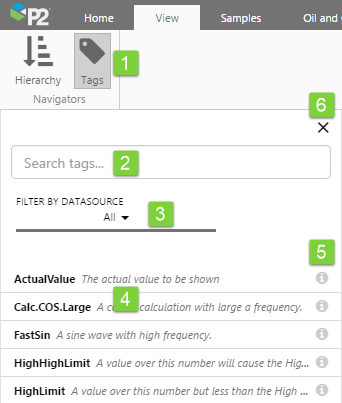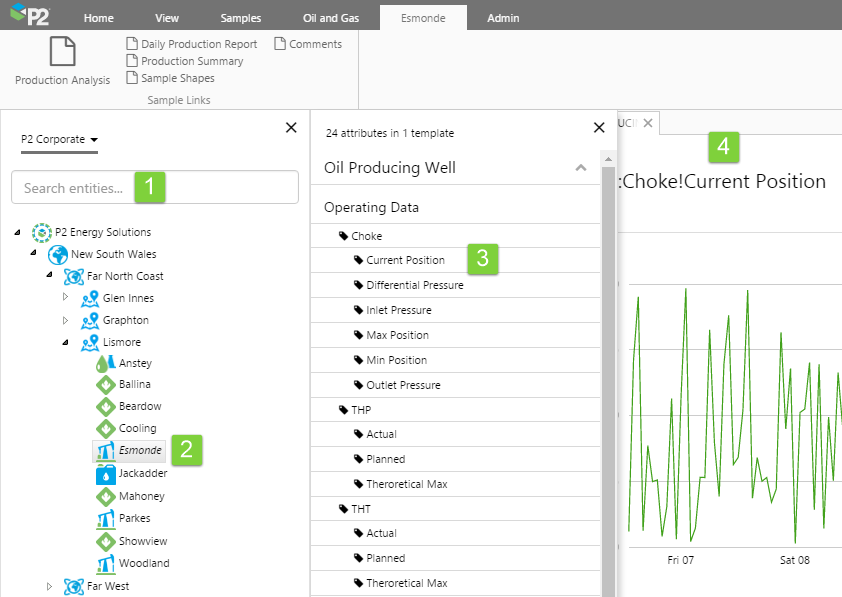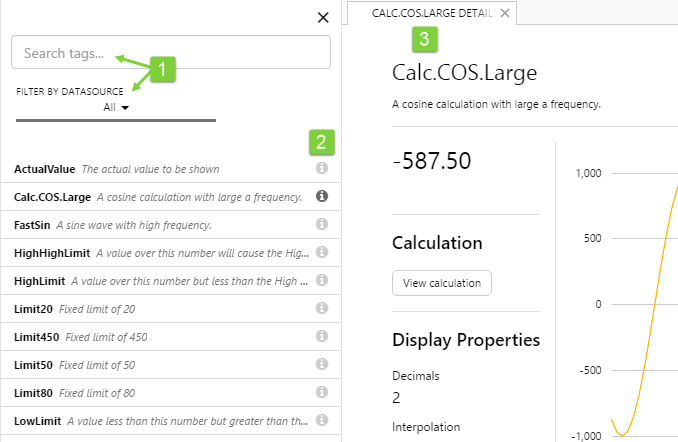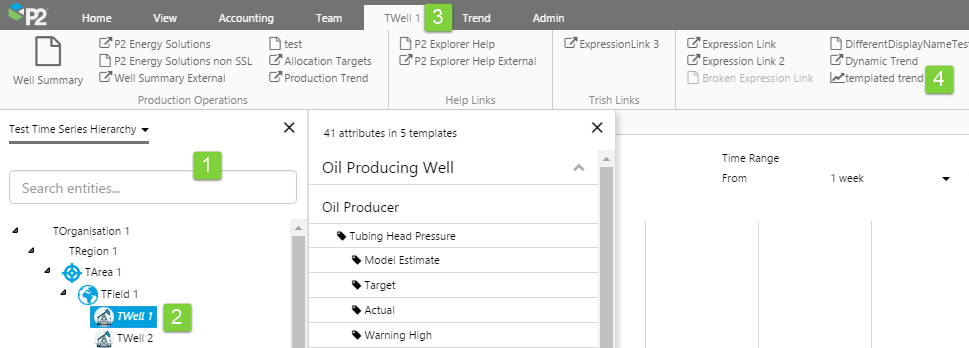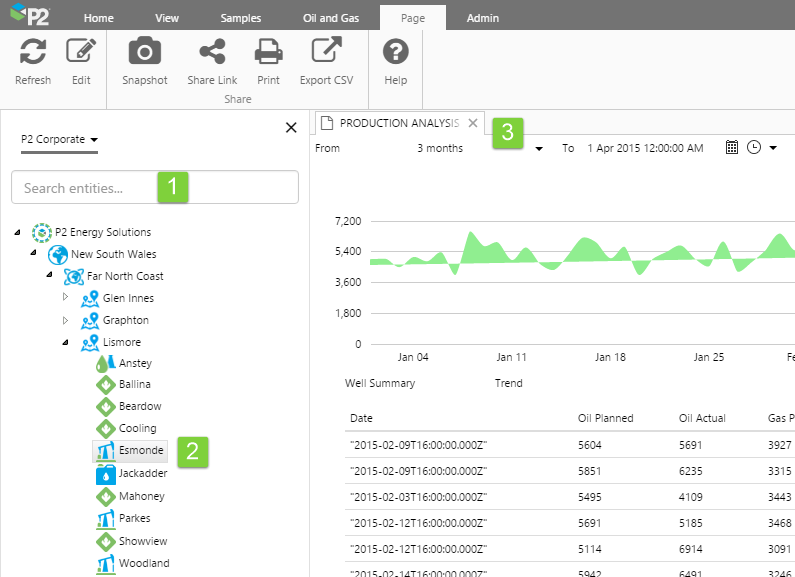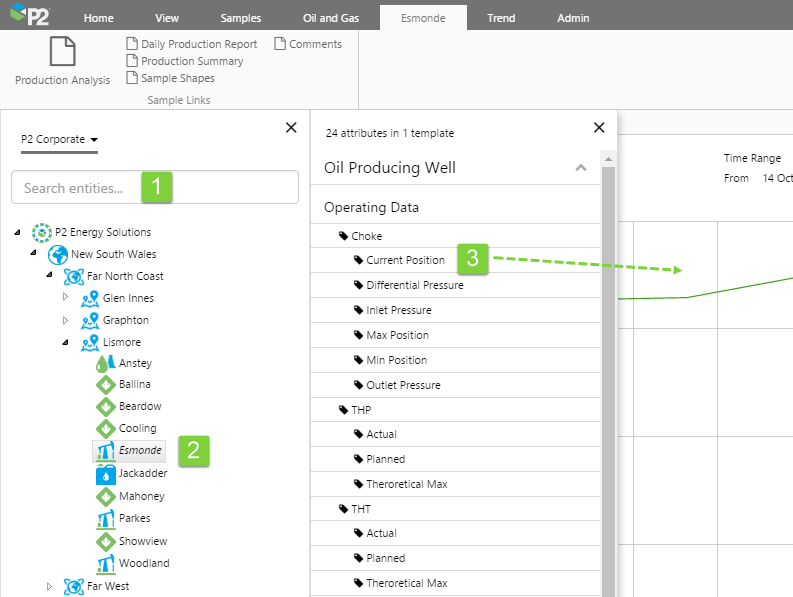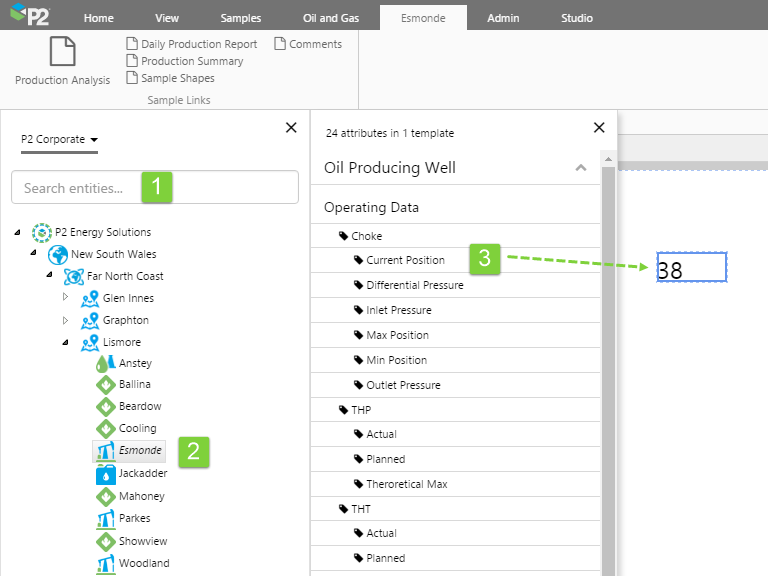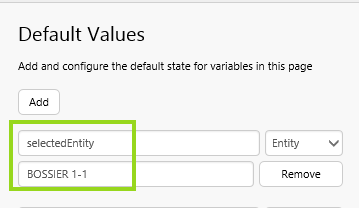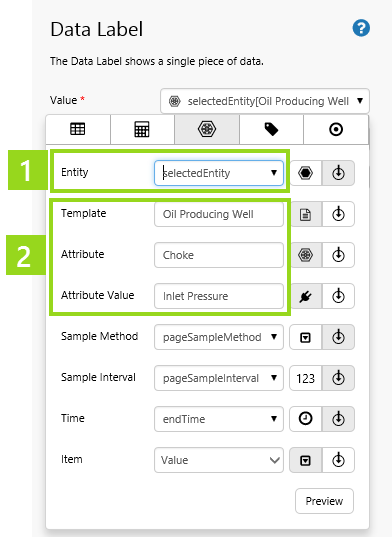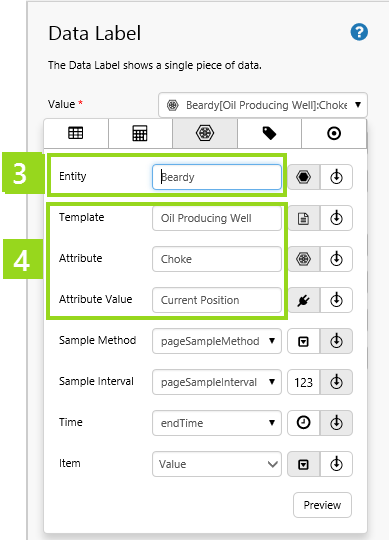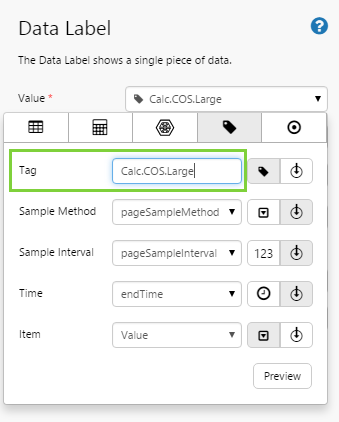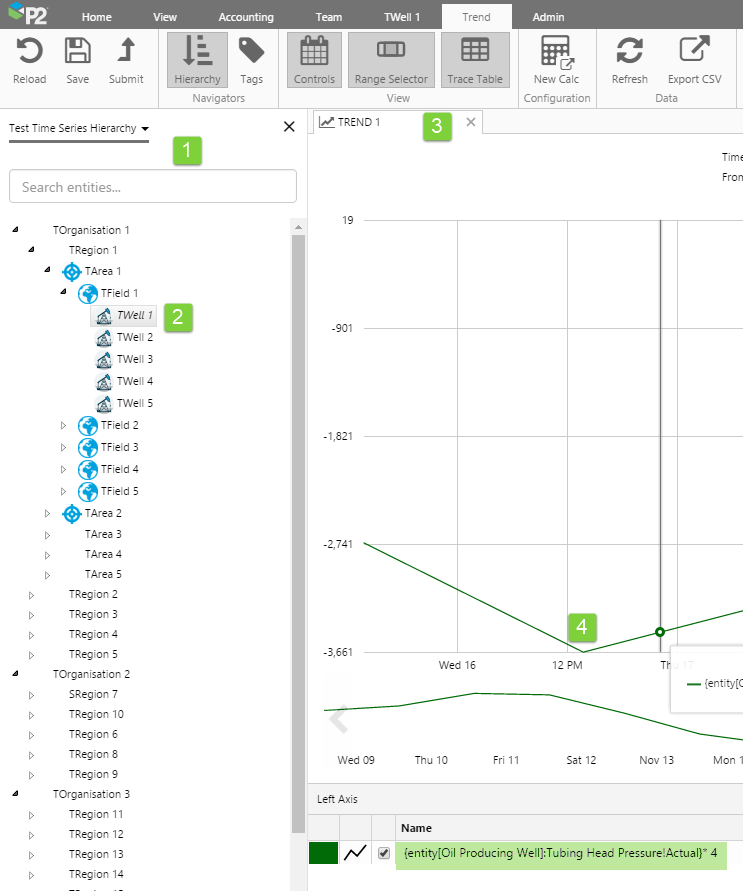ON THIS PAGE:
Overview
Tags and attributes values can be added to trends or viewed on pages, with or without calculations, to help you diagnose problems and visualise value changes over time.
Data that has been organised into a hierarchy in P2 Server can be located using Hierarchy Search or Navigation. A flat list of tags can be located using Tag Search.
This article shows you how to navigate or search for entities from a selected hierarchy, and then select attributes, as well as how to search for tags. The article also describes what you can do with tags and attribute values.
You can open the Hierarchy Panel or the Tags Panel from the Navigators group on the Explorer ribbon, which is available on the View, Studio and Trend tabs.

Navigators on the View Tab

Navigators on the Studio Tab

Navigators on the Trend Tab
Hierarchy Panel
Click Hierarchy on the View, Studio or Trend tab of the Explorer Ribbon to open the Hierarchy panel.
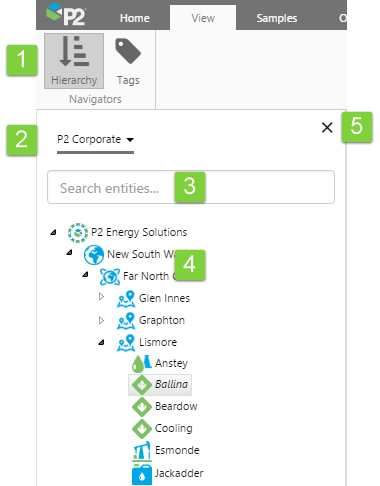 |
1. Hierarchy button:
2. Hierarchy selector:
3. Hierarchy Search box:
4. Hierarchy:
5. Close: |
Attribute Panel and Table of Contents
In the Hierarchy Panel, click an entity to open its Attributes Panel and Table of Contents ribbon tab.
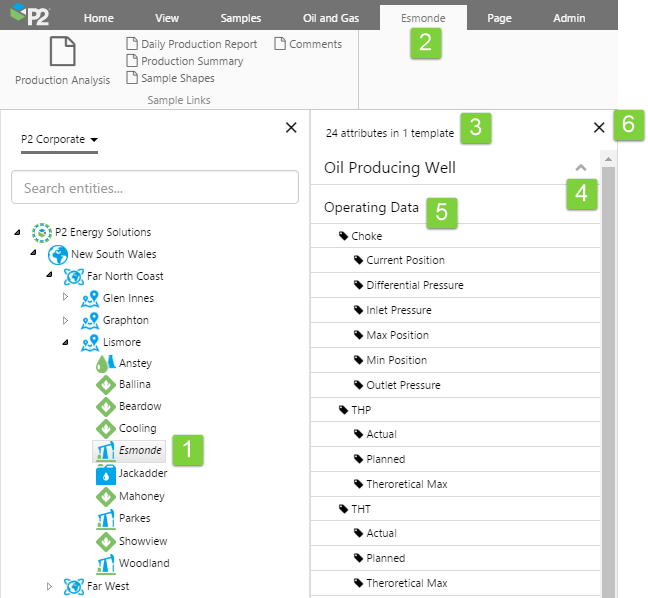 |
1. Selected entity:
2. Table of Contents: The Attribute Panel [3-6]:
3. Attributes and Templates Count:
4. Template:
5. Attribute Group, Attributes, and Attribute Values:
6. Close: |
Tags Panel
Click Tags on the View, Studio or Trend tab of the Explorer Ribbon to open the Tags Panel.
Functionality
There are several functions you can perform from the Tag, Hierarchy or Attribute panels.
- Open point details for a tag or attribute value
- Open an entity's Table of Contents tab
- Open an entity's primary link
- Drop a tag or attribute value onto a trend
- Select an entity for a templated calculation on a trend
The following functionality is for page designers only:
Open Point Detail
You can open the Point Details page for an Attribute Value (the Attribute Value Details page), or for a Tag (the Tag Details page).
Attribute Details
To open an attribute's details:
1. Locate an Entity: Search or navigate through a hierarchy to find your entity.
2. Select Entity: Click the entity to open the Attributes Panel for that entity.
3. Ctrl and Click: On the Attributes Panel, locate an attribute or an attribute value, then press the Ctrl key and click.
4. Attribute Value Details Page Opens: The attribute value details page opens for the selected attribute value (or for the default attribute value if you just select the attribute).
Tag Details
To open a tag's details:
1. Search for a Tag: Search or scroll to find a tag.
2. Details icon: Locate a tag, then click the details ![]() icon.
icon.
3. Tag Details Page Opens: The tag details page opens for the selected tag.
Open Table of Contents
If an entity's current primary template has links assigned, these appear in its Table of Contents on the Explorer Ribbon.
To open the Table of Contents:
1. Navigate to an entity in the Hierarchy Panel.
2. Click the entity.
3. A new tab containing the Table of Contents opens on the Explorer ribbon. The tab name displays the name of the entity.
4. Click on any of the links on the Table of Contents. For example, you can click on a templated trend, which uses attribute values for the entity.
Open an Entity's Primary Link
If an entity has a primary link, there is a short-cut method for opening this.
1. Navigate to an entity in the Hierarchy Panel.
2. Press the Ctrl key and click.
3. The primary link opens.
Alternatively, you can open the primary link (or any other of the available links) from the Table of Contents.
1. Click the entity to open its Table of Contents ribbon tab.
2. Click the primary link on the Table of Contents; this is the large button on the left of the ribbon.
Drop a Value on a Trend
You can drop a tag or an attribute value onto a trend.
First open a trend, or create a new trend.
The Hierarchy and Tags Navigators are also located on the Trend ribbon tab.
Attribute Values
To drop an attribute value onto a trend, first click Hierarchy on the Trend ribbon tab.
Tags
To drop a tag value onto a trend:
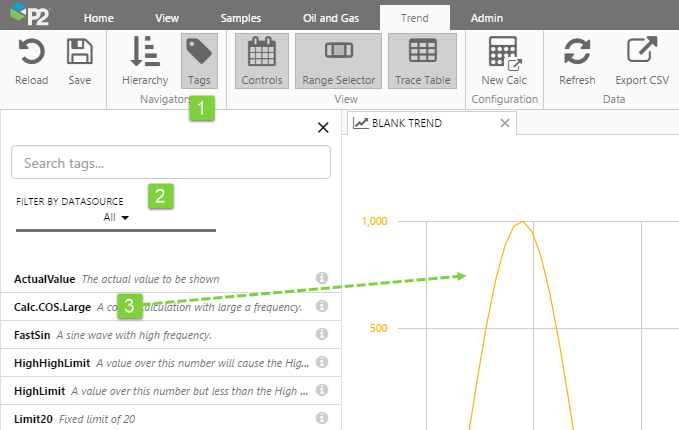 |
1. Open the Tags Navigator:
3. Drag and drop: The tag is added to the trend. |
Tags and attributes are listed in the trace table, as shown below.
| 1. |
Attribute (fully qualified) : |
This attribute was dragged onto the trend from the hierarchy entity's attribute list. It contains the Entity name (Beardy), the Template name (Oil Producing Well), the Attribute (Choke), and the Attribute Value (Current Position). |
| 2. | Tag: | The actual tag name, taken from the Tag Search. You can type this name in if you prefer, surrounded by curly brackets {}. |
| 3. | Attribute: | This attribute name has been typed in. Because the definition is missing the template name and the attribute value, the primary template, and the default Attribute Value are used. |
Drop a Value on a Page
You can drop a tag or an attribute value onto a page. When you drag and drop a tag or attribute onto a page, it is added to the page as a Data Label.
For attributes, this can either be an attribute value of the selected entity or of the default entity, depending on how you add it.
- Press Ctrl when you click and drag an attribute value onto a page, to use the page default variable, selectedEntity.
- Click and drag an attribute value onto a page, to use the entity selected in the hierarchy panel.
For tags, the tag selected in the Tag Panel is used.
First open a page, or create a new page.
The Hierarchy and Tags Navigators are also located on the Studio ribbon tab.
Attributes
To drop an attribute value onto a page: open the Hierarchy Navigator, navigate to an entity, and click it to open the Attribute panel. From the Attribute panel, drag and drop an attribute or attribute value onto the page.
|
Selecting an attribute versus selecting an attribute value: If you drag and drop an attribute value onto a page, that attribute value is used. If you drag and drop an attribute onto a page, the default attribute value is used. |
1. Locate an Entity: Search or navigate through a hierarchy to find your entity.
2. Select Entity:
3. Drag and drop: The selected attribute value of the selected entity is added to the page as a Data Label.
OR Ctrl during Drag and drop: The selected attribute value of the Page Default selectedEntity is added to the page as a Data Label. |
Note: The first time you drag and drop an attribute onto a page, the page default value for SelectedEntity is assigned the value of that attribute's entity.
If you want to use the selectedEntity default when you drag another attribute or attribute value onto the page, press Ctrl while you drag and drop.
When you open the resulting Data Label, the data label properties depend on how the value was added.
|
Ctrl during drag and drop for an attribute value onto a page: 1. The entity is the page default variable, selectedEntity. 2. The template, attribute and attribute value that was dropped onto the page. |
Drag and drop an attribute value onto a page: 3. The entity selected in the Hierarchy Panel is used here. 4. The template, attribute and attribute value that was dropped onto the page. |
Tags
To drop a tag value onto a page: search for a tag in the Tags Navigator. Then drag and drop the tag onto the page.
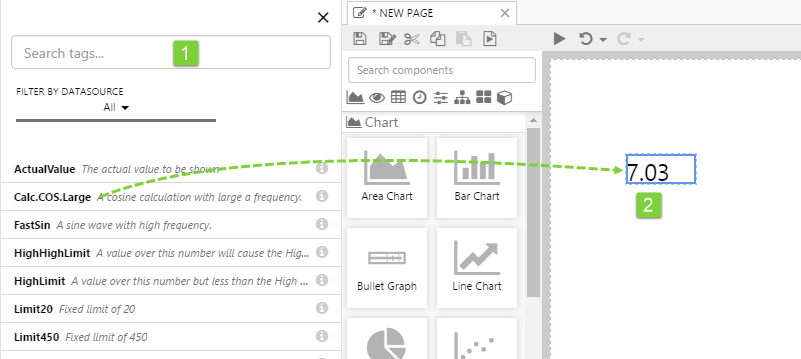 |
1. Locate a Tag: Search or scroll to find a tag.
2. Drag and drop: The tag is added to the page as a Data Label. |
When you open the resulting Data Label, the tag selected in the Tag Panel is used as the Value.
Drop a Value on a Component
Some of the Studio components can have data dropped into their Data Selectors straight from the Hierarchy or Tag Navigators.
This functionality is available for some of the Studio components only. For example:
- Level Meter
- Temperature Meter
- Data Table
First open a page in Studio, and click on a component to edit it.
Drag an Attribute Value onto a Component's Property
1. On the page, click the component to open the component editor.
2. Locate an entity on the Hierarchy Navigator.
3. Drag and drop an attribute value into the applicable property (Data Selector) of the component. As you move over the fields in the component editor, the ones that you can drag and drop into are highlighted in blue.
Drag a Tag onto a Component's Property
1. On the page, click the component to open the component editor.
2. Locate a tag in the Tags Navigator.
3. Drag and drop the tag into the applicable property (Data Selector) of the component. As you move over the fields in the component editor, the ones that you can drag and drop into are highlighted in blue.
Select an Entity for a Templated Trend
If a trend's trace uses a templated calculation, the entity portion of the calculation is controlled from the Hierarchy Navigator.
1. Search for an entity in the Hierarchy Navigator.
2. Click the entity. If the entity has the same attribute value as that used in the templated calculation, then the trace templated calculation uses this.
3. Open a trend that uses the entity in a templated calculation. (Tip: This could be from a link on the Table of Contents for the entity.)
4. The trace appears for the templated calculation, using the selected entity.
Example: A trend may include the following templated calculation in its trace table: {entity[Oil Producing Well]:Tubing Head Pressure!Actual} * 4. If the selected entity (for example, TWell 1) uses the Oil Producing Well template, then Server fetches values for TWell 1 attribute values: Tubing Head Pressure!Actual}. Each value is multiplied by 4, and then displayed in the trend.
Videos
Watch the following videos to see how tags and attribute values can be used. Note: The videos use Explorer 4.4.5.
This video shows how to drop attributes and tags onto a trend.
This video shows how to drop attributes and tags onto a page.
This video shows how open point details for a tag or attribute value. Press Ctrl and click on a tag or attribute value.
This video shows how to open an entity's primary link. Press Ctrl and click on an entity.
Release History
-
Tag Search and Hierarchy Navigation 4.4.6 (this release)
- Updated the layout of the Tags Navigator
-
Tag Search and Hierarchy Navigation 4.4.5
- Added ability to select entities on the Hierarchy Navigator, to provide context to templated trends
- Tag Search and Hierarchy Navigation 4.4
- Tag Search and Hierarchy Navigation 4.3.1
